Modest Beginnings, Towering Legacy:
The Negro Ensemble Company
Out of conversations and readings in an actor’s apartment,
one of the great American theatre companies was born.
By Hinton Battle, Dr. Dorothy Marcic, & Kimberley Lamarque Orman
Originally published in American Theatre, January 13, 2021
Tapestry of American Black Theatre is a new series chronicling the too often forgotten contributions of Black theatremakers in the U.S. This first article tells the story of the Negro Ensemble Company, formed during and alongside the Civil Rights Movement. Future articles will explore some of the many Black Theatre organizations, leaders, performers, and work. There are currently nearly 90 Black theatres in the United States.
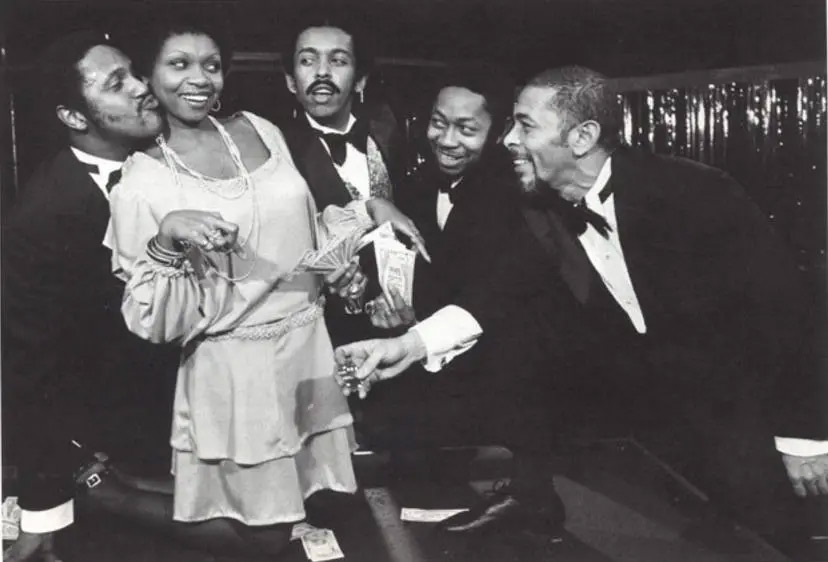
Charles Weldon, Hattie Winston, Howard Porter, Sati Jamal, and Adolph Caesar in the musical “The Great MacDaddy” at Negro Ensemble Company in 1977.
Black theatre in the U.S. helped start and nurture the careers of the likes of Denzel Washington, Phylicia Rashad, Ruby Dee, Angela Bassett, Debbie Allen, Laurence Fishburne, and other Oscar, Emmy, and Tony winners, all of whom perfected their craft in the environment of Black theatre. Separate and distinct from themes of white, European-based theatre, Black theatre found success in exploring stories of African American lives, hopes, dreams, and history. Though it finally became a recognizable entity and force in the 1960s during the U.S. Civil Rights Movement, Black theatre in this country can trace its roots to at least 140 years earlier, with the founding of the African Grove Theatre.
Among the preeminent Black theatres in the U.S.: Negro Ensemble Company.
Where Are the Black Characters?
As a young man, Robert Hooks went to lots of theatre and always asked himself: “Where are the Black characters in these plays? Where are the Black stories? When will I see Black characters not carrying trays or waiting on somebody?” His questions were answered in 1959 with Broadway’s A Raisin in the Sun, in which Hooks got to work with other Black artists, including Ossie Davis, Ruby Dee, and playwright Lorraine Hansberry.
Another answer came in 1961, when Hooks performed in Jean Genet’s racial exploration The Blacks, which New York Times critic Howard Taubman called it “exhilarating to the ear and eye and provocative to the mind…‘The Blacks’ makes theatregoing the adventure it should be.”
At one performance of The Blacks in 1962, the audience included Dr. Martin Luther King Jr. and Coretta Scott King. As Hooks explained, “Martin had seen A Raisin in the Sun and knew what we were doing, how we were building a Black audience. After the show, we all went out to dinner, and I started apologizing for not being on the front lines with them down South during the Civil Rights marches. Martin said, ‘No, no, no. What you are doing on the stage, keep doing it. Keep doing the Black plays and building Black audiences. The movement needs this.”
Hooks followed that advice, continuing to work in theatre and raising funds with meetings and readings at the homes of the likes of Lena Horne, Harry Belafonte, and James Baldwin.
Another answer came in 1961, when Hooks performed in Jean Genet’s racial exploration The Blacks, which New York Times critic Howard Taubman called it “exhilarating to the ear and eye and provocative to the mind…‘The Blacks’ makes theatregoing the adventure it should be.”
At one performance of The Blacks in 1962, the audience included Dr. Martin Luther King Jr. and Coretta Scott King. As Hooks explained, “Martin had seen A Raisin in the Sun and knew what we were doing, how we were building a Black audience. After the show, we all went out to dinner, and I started apologizing for not being on the front lines with them down South during the Civil Rights marches. Martin said, ‘No, no, no. What you are doing on the stage, keep doing it. Keep doing the Black plays and building Black audiences. The movement needs this.”
Hooks followed that advice, continuing to work in theatre and raising funds with meetings and readings at the homes of the likes of Lena Horne, Harry Belafonte, and James Baldwin.
Then came Dutchman.
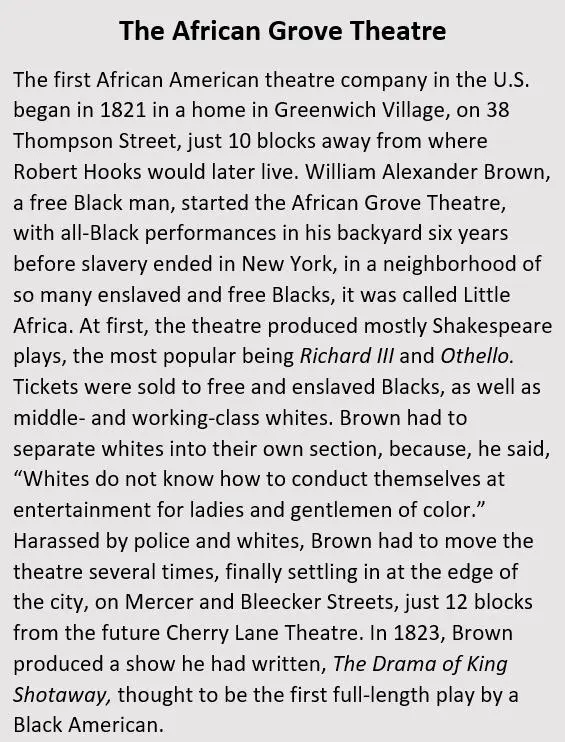 This incendiary play by LeRoi Jones, later known as Amiri Baraka, about Black and white dynamics was presented at the Cherry Lane Theatre. It became an Off-Broadway hit and an Obie winner, providing many Black audiences with their first glimpse of Blacks onstage in a play of explosive realism about racial relations. So charged was it with the truth of centuries of oppression that playwright Richard Wesley called it “a game changer.” It resonated for Blacks, less so whites. This is epitomized by another review by Taubman. “Everything about LeRoi Jones’s ‘Dutchman’ is designed to shock—its basic idea, its language, and its murderous rage…If this is the way Negroes really feel about the white world around them, there’s more rancor buried in the breasts of colored conformists than anyone can imagine,” he wrote March 25, 1964.
This incendiary play by LeRoi Jones, later known as Amiri Baraka, about Black and white dynamics was presented at the Cherry Lane Theatre. It became an Off-Broadway hit and an Obie winner, providing many Black audiences with their first glimpse of Blacks onstage in a play of explosive realism about racial relations. So charged was it with the truth of centuries of oppression that playwright Richard Wesley called it “a game changer.” It resonated for Blacks, less so whites. This is epitomized by another review by Taubman. “Everything about LeRoi Jones’s ‘Dutchman’ is designed to shock—its basic idea, its language, and its murderous rage…If this is the way Negroes really feel about the white world around them, there’s more rancor buried in the breasts of colored conformists than anyone can imagine,” he wrote March 25, 1964.
Watching a play like Dutchman, which spoke to deep feelings resulting from generations of bias, condescension, and violence, may have been difficult for many whites. But it gave voice to words Black folks said to one another that weren’t usually heard by the dominant group. Hooks knew this play was breaking ground.
During the run of the play, he spoke to an audience at the Hudson Guild about the Civil Rights movement, his life as an actor, and Black theatre in general. After the talk, 15 young Black people followed him outside, talking under basketball hoops, asking questions about how they could be part of theatre. Hooks decided to invite them to his nearby apartment on Monday evenings to talk; they soon started doing play readings. Before long the group had swelled to 35, and he ran out of space.
“We ended up with crowbars and hammers, and we knocked down a wall and built a stage,” Hooks recounted. “I knew once the landlord found out, I’d be evicted, but it was worth it to create a 30-seat theatre, to get these kids off the streets, away from gangs, to introduce them to ideas relating to the burgeoning Civil Rights Movement.”
Monday nights became so popular, Hooks brought in Dr. Barbara Ann Teer, an Alvin Ailey-trained dancer and Broadway performer, whose 1962 knee injury caused her to shift her focus to theatre. Teer later formed her own company, the National Black Theatre. Those kids in 1964 wanted to learn acting, writing, and dance, so, Hooks started the Group Theatre Workshop, named after Hooks’s all-time favorite theatre organization, the legendary Group Theatre, formed in 1931 by Lee Strasberg, Cheryl Crawford, and Harold Clurman.
Soon the Group Theatre Workshop would need another space. To the relief of Hooks’s neighbors, who thought he was up to nefarious activities in his expanded living room, Hooks was forced to evacuate his apartment. Rescue came from the Cherry Lane, which allowed Hooks and Teer to use the stage on Monday nights. They started by rehearsing a showcase, with readings from Baldwin, poetry, and a short play, Happy Ending, which was often paired with Day of Absence, both by Douglas Turner Ward. Ward was motivated to continue the legacy of W.E.B. Du Bois, and his plays use farce, irony, absurdism, and satire to show stereotypes and attitudes endemic in the environment inside and outside the Black community.
The night of the showcase, New York Post theatre critic Jerry Tallmer happened to be in the audience, and turned in a rave, mostly about the short play by Ward, who had no idea a critic would be there. Ward later told Tallmer, “You gave me a heart attack. I’m on the Metroliner to Washington and I see this headline: ‘A hilarious play,’ and it’s my play!” This success was a confidence booster. Hooks told Ward, “If Jerry Tallman is writing a review of this play in such glowing terms, and we did it with young people, why not let me produce your plays with real actors?”
After some negotiations with another producer who’d been working with Ward, Hooks got his permission. He then started his own theatre company, Robert Hooks, Inc., which produced the double bill of Happy Ending and Day of Absence. These opened November 1965 at the St. Mark’s Playhouse, on the second floor of a 2nd Avenue Greenwich Village movie theatre, and ran for 15 months and 504 performances; Obie and Drama Desk awards followed. Recalls Hooks, “It was the first Black show written by a Black writer and funded by Blacks. Even A Raisin in the Sun had been put up with white money.”
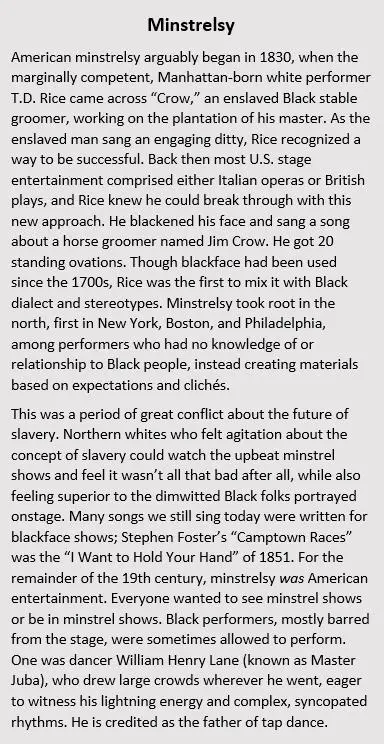 Day of Absence was about a Southern town where one day Black people mysteriously disappear and the whites are thrown into chaos, with no one to tend children, or help run their businesses or government offices. Performed by a Black cast in reverse minstrel style, the play was meant to show the bigotry on both sides, not only from whites.
Day of Absence was about a Southern town where one day Black people mysteriously disappear and the whites are thrown into chaos, with no one to tend children, or help run their businesses or government offices. Performed by a Black cast in reverse minstrel style, the play was meant to show the bigotry on both sides, not only from whites.
Because Ward was getting recognition as a writer, The New York Times invited him to write an article about Blacks and the American theatre. In August 1966, his manifesto, “American Theater: For Whites Only?,” set off alarm bells, bringing an awareness of the need for Black stories, told from a Black perspective and produced by a resident Black theatre company, minimum Off-Broadway magnitude, to serve primarily Black artists and audiences.
W. McNeil Lowry of the Ford Foundation took note of the Times article and called for a meeting with Hooks and Ward. They both knew a business-minded person was needed, so they brought in Gerald Krone, who, with his wife, Dorothy Olim, had been company manager on Dutchman and Happy Ending/Day of Absence. The three men met at a Ukrainian restaurant, the Orchidia, one block from St. Mark’s Playhouse, and wrote out their whole proposal on the paper tablecloth. Hooks explains: “The Ford Foundation gave us a three-year grant of $1.5 million, which is $12 million in today’s dollars, to start a theatre company. That was the beginning of the Black theatre movement.”
The goals of the grant were to found a Black repertory company with social themes, which would expand opportunities for experienced Black theatre artists and to help train new ones. The Negro Ensemble Company officially began in 1967, with its home at the St. Mark’s Theater. This is only 16 blocks from where the African Grove Theatre started 146 years previously, in 1821, on 38 Thompson Street.
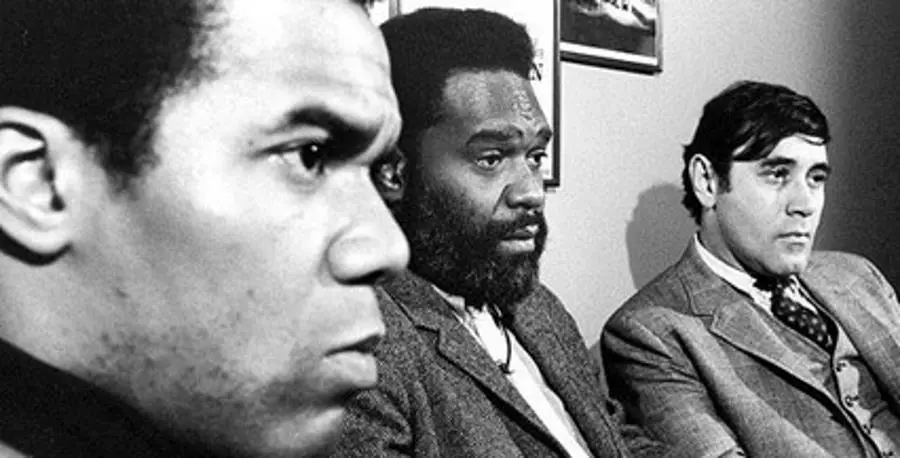
The founders of Negro Ensemble Company: Robert Hooks, Douglas Turner Ward, and Gerald Krone.
Ups, Downs, More Ups
Hooks and his partners got a great deal of flak about their name. It was the age of Black Power, and some thought this new organization should have Black in its name, not “Negro.” But Hooks, Ward, and Krone stuck with the name to honor their heritage. As Hooks puts it, “We took it from the Harlem Renaissance, because we wanted to pay homage to those artists, who were Negroes. Langston Hughes and all the great artists were Negroes.”
NEC would go on to run that resident theatre for decades, employing actors, directors, playwrights, lighting and costume designers, choreographers, and so on. In addition, its training programs held classes in dance, speech, playwriting, acting, costume and scenic design, and administrative management. One of the troupe’s first moves was to incorporate the 25 young people from Hooks’s original Group Theatre Workshop apprentice program into NEC. Other young people aged 16 to mid-20s were offered beginners’ classes, with advanced classes for the more experienced. With over 3,000 students trained in its heyday, NEC helped raise up a generation of Black talent for the larger theatre community and other media.
Not everything went smoothly. NEC tried to line up Black funders, but those were almost non-existent back then. Some folks said they weren’t Black enough because they worked with some white writers. But Hooks says their vision from the beginning was to be an international theatre company—a Black company, with work speaking to the world. In their first season, they had plays by two Black writers, Richard Wright’s Daddy Goodness, African Wole Soyinka’s Kongi’s Harvest, and two by white authors: Australian Ray Lawler’s tale of sugar-cane workers, Summer of the Seventheenth Day, and Peter Weiss’s satiric anti-colonial play Song of the Lusitanian Bogey.
In 1969, NEC had the honor to be chosen as the only U.S. theatre company to represent the nation’s theatre at the World Theatre Season at the Aldwych Theater in London, England. The honor came at a cost, as the troupe performed Song of Lusitanian Bogey and got heckled by right-wing protesters who resented the play’s anti-imperialistic message; some audience members hurled the N-word and assorted objects at the actors, among them Hattie Winston, an enormously talented performer who went on to Broadway roles and had an extensive film and television career.
When the Ford Foundation money ran out, NEC faced budget problems. By 1972, there were cutbacks in training programs, the resident company, and salaries. Though they had a history of successful and often sold-out performances, St. Mark’s Theatre had just 145 seats, with tickets costing $5.95, so box office came nowhere near meeting their expenses. The difficult decision was made to scale back to just one play a year.
Fortune smiled on NEC when it chose The River Niger by Joseph A. Walker. The tale of a poet forced to paint houses to support his family, it detailed class conflicts among three generations of a Harlem household. With Douglas Turner Ward directing, it opened at St. Marks on Dec. 5, 1972 and quickly moved to Broadway the following March, where it played for 182 performances over nine months. Alongside rave reviews, the play garnered Tonys for the best play and acting nominations for Roxie Roker (mother of musician Lenny Kravitz) and for Douglas Turner Ward, both of whom had also won Obie awards for their roles. The film version in 1976 starred Cicely Tyson and James Earl Jones.
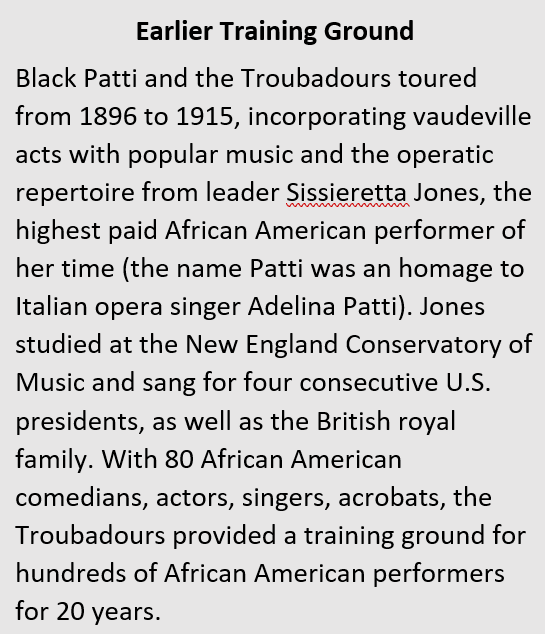 The success of River Niger helped fund NEC’s work for the next 10 years. Exploring new frontiers, NEC produced its first musical in 1974. The New York Times theatre critic Clive Barnes, wrote that audiences watching The Great MacDaddy were “witnessing the birth of the Black musical, with storytelling techniques and dramatic rhythms as distinct from the white musical as jazz is distinct from the Viennese waltz.” (Maybe Barnes forgot about 1921’s Shuffle Along?)
The success of River Niger helped fund NEC’s work for the next 10 years. Exploring new frontiers, NEC produced its first musical in 1974. The New York Times theatre critic Clive Barnes, wrote that audiences watching The Great MacDaddy were “witnessing the birth of the Black musical, with storytelling techniques and dramatic rhythms as distinct from the white musical as jazz is distinct from the Viennese waltz.” (Maybe Barnes forgot about 1921’s Shuffle Along?)
Then came another hit, perhaps the theatre’s biggest. A Soldier’s Play by Charles Fuller, directed by Douglas Turner Ward, opened at the theatre’s new location, Theater Four (now the Julia Miles Theater) at 424 W. 55th Street; it played 469 performances in 14 months, followed by two years of touring. Telling the story of the murder of a sergeant in an all-Black army outpost in WWII-era Louisiana, the play dramatizes a conflict between Black pride and Black self-loathing. Among the play’s numerous awards was the 1982 Pulitzer for Fuller, making him only the second African American to win that prize in Drama. It was made into a successful film in 1984, featuring much of Off-Broadway cast, which was nominated for three Oscars. The play launched the career of Denzel Washington, and gave a boost to Samuel L. Jackson, Larry Riley, and Adolph Caesar as well. Fuller has said he thinks A Soldier’s Play never made it to Broadway (until 2020) because it was too radical, in particular its last line: “You’ll have to get used to Black people being in charge.”
For all its ups and downs, the Negro Ensemble Company was arguably the most successful Black theatre group in the world. (There is still an organization under the name, but it doesn’t produce seasons or have a theatre space.) Its major awards number 40, from that Pulitzer to two Tonys, 13 Obies, and NAACP Image Awards. Producing more than 200 plays, NEC also offered artistic development and work to over 4,000 cast and crew, including some of the best known Black actors today. (List below.)
All because Robert Hooks listened to those young Black folks under the basketball hoops, because he took Dr. King’s counsel to build a Black audience, and because he had the vision, the audacity, and the ability to attract generous funders and talented people with widely varying skills, all of whom helped build one of American Black theatre’s strongest foundations.
Noteworthy alumni of the Negro Ensemble Company:
Mary Alice
Debbie Allen
John Amos
Angela Bassett
Paul Benjamin
Earl Billings
Avery Brooks
Charles Brown
Graham Brown
Roscoe Lee Browne
Adolph Caesar
L. Scott Caldwell
Godfrey Cambridge
Rosalind Cash
Anthony Chisholm
Bill Cobbs
Keith David
David Downing
Bill Duke
Judyann Elder
Laurence Fishburne
Frances Foster
Arthur French
Charles Fuller
Danny Glover
Carl Gordon
Louis Gossett Jr.
Layon Gray
Moses Gunn
Kevin Hooks
Samuel L. Jackson
Cleavon Little
Judi Ann Mason
S. Epatha Merkerson
Barbara Montgomery
Denise Nicholas
Roscoe Orman
James Pickens Jr.
Phylicia Rashad
Larry Riley
Roxie Roker
Esther Rolle
Richard Roundtree
Ruben Santiago-Hudson
Cotter Smith
Clarice Taylor
Barbara Ann Teer
Glynn Turman
Denzel Washington
Charles Weldon
Lynn Whitfield
Billy Dee Williams
Samm-Art Williams
Hattie Winston
###
Hinton Battle is a three-time Tony winner whose Broadway credits include The Wiz, Bob Fosse’s Dancin’, Dreamgirls, Sophisticated Ladies, Chicago, Miss Saigon, and The Tap Dance Kid. He is currently the co-founder and director of the Hinton Battle Dance Academy (HBDA) in Tokyo.
Dorothy Marcic, Ph.D., is a Columbia University professor, Fulbright Scholar, and playwright of Respect: The Musical and Sistas: The Musical, the longest-running African American musical Off-Broadway. She’s the writer of 21 bestselling books and award-winning screenplays, and is co-creator of the Wondery podcast Man-Slaughter.
Kimberley LaMarque Orman, a professor at Fordham University and executive producer of the video series Fordham Road, has produced, acted, and directed in a variety of productions across the U.S., including Joe Turner’s Come and Gone, Jar the Floor, Macbeth, In the Blood, Blues for an Alabama Sky, Romeo & Juliet, Three Sisters, Ma Rainey’s Black Bottom, and The Old Settler.

